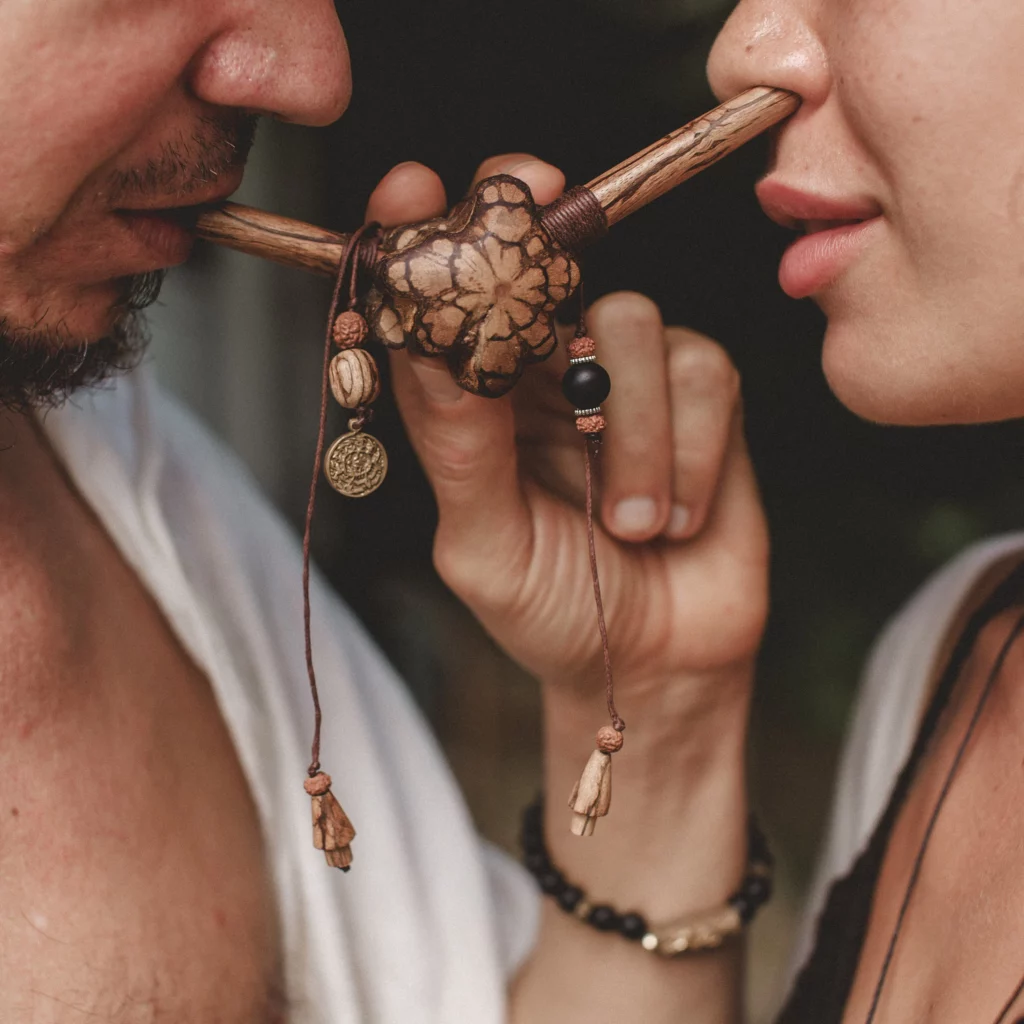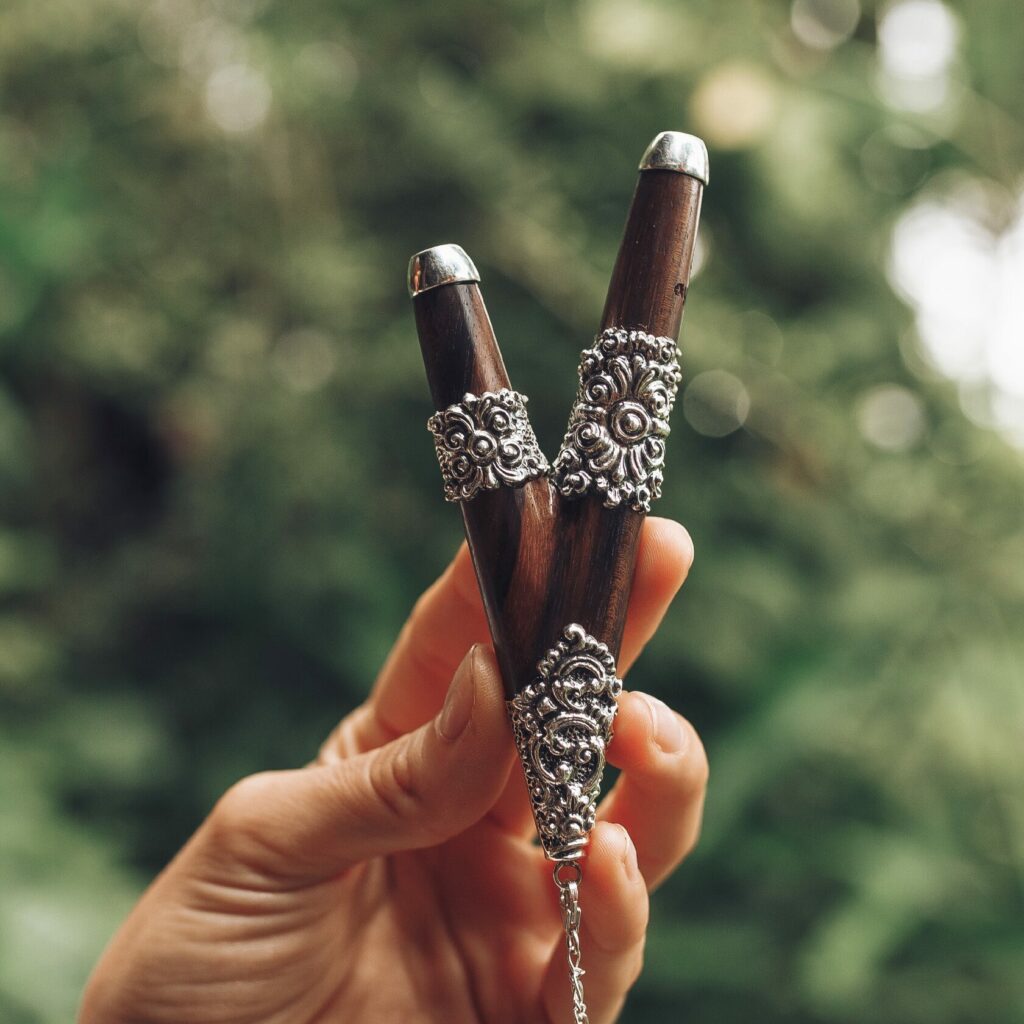Rapé is a sacred medicine from the Amazon that’s used to overcome physical, psychological, and emotional blocks as well as gain insight into other worlds.
Working with plants for their medicinal, psychoactive, spiritual, and transformative properties has been practiced across cultures for millennia. Tobacco is one such plant that we don’t usually think of as “sacred” or “medicinal,” despite the fact that it may be both. Most people, on the other hand, believe tobacco to be a habit-forming, hazardous toxin that can lead to fatal illnesses like cancer.
Table of contents
- What is Shamanic Snuff (Amazonian Rapé)?
- How Shamanic Snuff is Used
- What Shamanic Snuff Is Made From
- The Medicinal Properties of Rapé as a Healing Tool
- A Shamanic Guide to Rapé in the Modern Age
- The Right Set and Setting for a Rapé Ritual
- What You May Experience After Using Rapé
- Safety
- Storing Rapé
- Where to find Rapé online?
- Is it legal to possess and use Rapé?
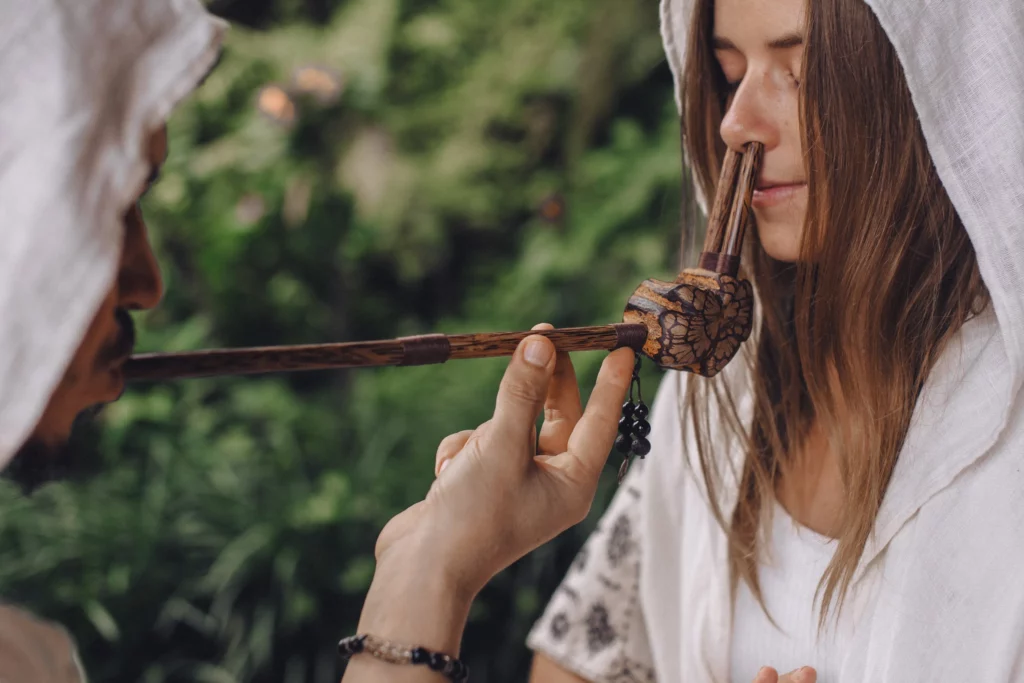
What is Shamanic Snuff (Amazonian Rapé)?
Shamanic Snuff, also known as Rapé, pronounced “ha-peh” or “rapay”, is a traditional shamanic medicine used by indigenous tribes in the Amazon rainforest. It is made from the ashes of certain plants and trees and is traditionally used for cleansing ceremonies and spiritual rituals.
Rapé has a long history of use among indigenous peoples in the Amazon and is said to have a wide range of medicinal and spiritual benefits. It is used to treat a variety of ailments, including headaches, colds, flu, and depression. It is also said to improve mental clarity, focus, and concentration. Shamanic snuff is usually taken in small amounts and is usually blown into the nostrils of the recipient.
Rapé is a preparation of powdered medicinal herbs, often with a tobacco base. Rapé’s unique flavor comes from its use of Nicotiana rustica – also known as Mapacho in South America- which contains 9 times more nicotine than tabacum.
The use of tobacco by native tribes was not for smoking but rather in ceremonies, to predict good weather, or for fishing. They also used it as a spiritual aid and healing treatment when needed. Shamans would use tobacco in a pipe as an offering to the spirits, and this is still done today.
Nowadays Shamanic Snuff is used in Shamanic Healing practices to connect with the spiritual realm and for Shamanic journeying. It can be used as an offering to the earth and the spirits, to cleanse and purify oneself and others, or to bring about good luck. Shamanic snuff is also used in some Shamanic ceremonies to induce an altered state of consciousness.
The practice of taking powdered plant medicines through the nose is much older than we previously believed, having been used by Brazilian indigenous tribes for centuries. Francisco Hernández de Boncalo, a doctor and botanist, brought herbal snuff to Spain in 1577. Snuff was popular among the aristocracy during the 18th century because it relieved headaches. Inhaling snuff became fashionable during the 19th century.
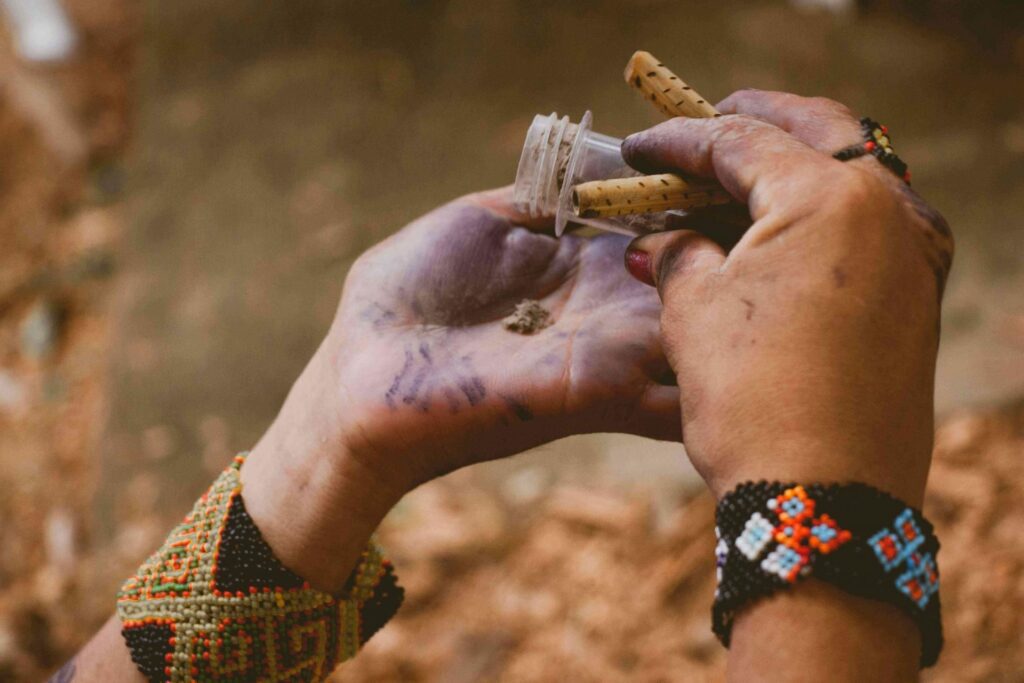
How Shamanic Snuff is Used
Indigenous tribes in the Amazon continue to use rapé for all aspects of life. From formal ritual uses during puberty, initiation, and cashiri drinkings festivals or social gatherings; it is also used as a healing medicine alone or with friends.
In today’s world where we are so connected yet disconnected due to this technological advancement – many people find themselves lost between what they knew before versus now being thrown into society without any support systems available which can make them feel disoriented at times – these native South American cultures have always valued connecting deeply both physically within their communities, but more importantly mentally amongst each other and with nature.
Shamanic snuff is usually taken in small amounts and is usually blown into the nostrils of the recipient. It can also be taken orally, but this is not as common. Shamanic snuff is usually taken during Shamanic ceremonies or Shamanic healing practices.
The effects of Shamanic snuff can vary, depending on the plant used to make it, the method of preparation, and the intention with which it is used.
From the indigenous perspective, rapé is a sacred medicine with profound healing effects and can produce a variety of effects, including increased mental clarity and focus, improved concentration, and enhanced well-being. Shamanic snuff can also induce an altered state of consciousness, which can be used for Shamanic journeying and spiritual exploration.
Because rapé is a powdered snuff that is administered through the nose, its effects are felt quickly and intensely.
The ritual use of rapé is also making its way around the world, introduced to the West through ayahuasca ceremonies by traveling shamans and those who have spent time in the jungle with indigenous communities.
Shamanic snuff is not habit-forming and is considered to be safe when used in moderation. Shamanic snuff can be made at home, but it is best to consult with a Shaman before doing so.
What Shamanic Snuff Is Made From
The process of making rapé is long and tedious, often done in a ceremonial setting. This gathering of sacred plants for medicinal purposes requires an experienced shaman who knows about the forest’s plant life.
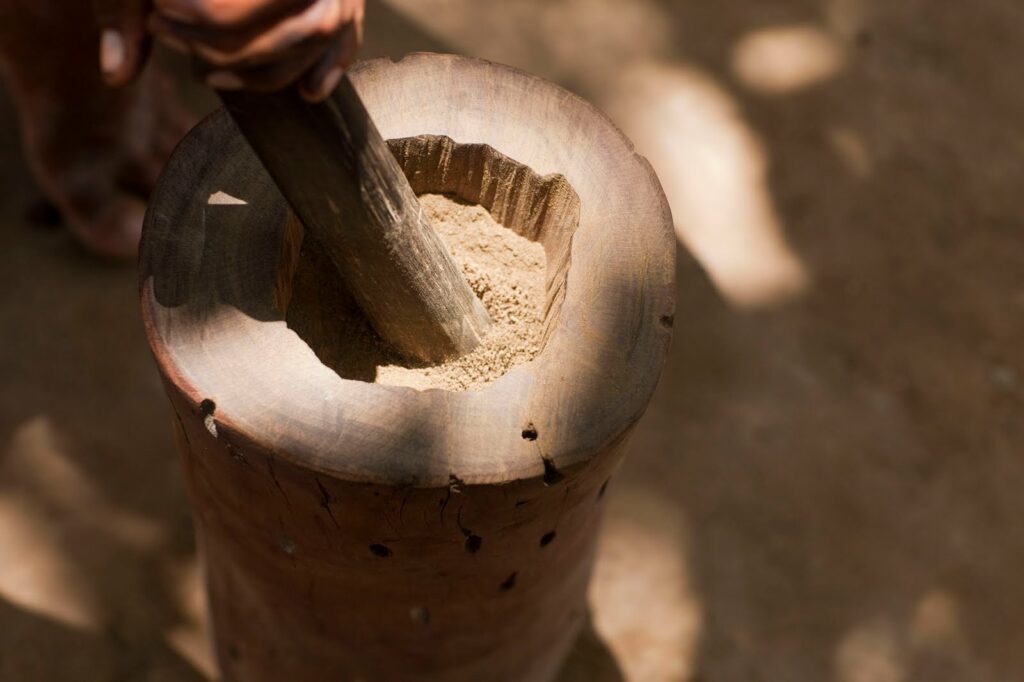
The shaman must have a deep understanding of the Amazon rainforest’s medicinal plants and must also be aware of which part of each plant may be used. A plant’s root bark, for example, might have a distinct purpose and impact than its leaves or seeds.
The sacred process of preparing medicinal rapé may take weeks, and the art of making rapé is a sacred and difficult process that takes years to master, because different blends of rapé may involve complex processes, such as harvesting and preparing different plants.
Shamanic snuff is traditionally made from the ashes of certain plants and trees. The most common plants used to make Shamanic snuff are Tobacco, Mapacho, Cebil, Clavo Huasca, Sananga, and Mapacho.
Rape can be prepared with ashes from Sapota bark, and ashes of Banesteriopsis Caapim, Capemba, or Tsunu.
Shamanic snuff is usually made by Shaman, but it can also be made at home. Shamanic snuff made from any of these plants can be used to produce a variety of effects, depending on the plant used and the intention with which it is used.
The Medicinal Properties of Rapé as a Healing Tool
Rapé can also be combined with other mind-altering plants, such as coca, jurema, or yopo for additional effects. It is also known to potentiate the healing power of other plants like ayahuasca. Furthermore, rapé is said to aid in the release of emotional, physical, and spiritual illnesses while relieving negativity and confusion.
Medicinal rapé is also used to treat a variety of illnesses, sores, wounds, and as protection from insects. It’s also an analgesic and narcotic that relieves tiredness, pain, hunger, and thirst. There are various distinct rapé mixtures created to combat the flu and other diseases.
In addition to helping clear out toxins and bacteria, shamans use rapé to help them detoxify their bodies, re-align with their energy channels, connect with their higher selves, and deepen their connection with the natural world.
Tobacco, for example, is said to be a powerful cleansing agent that can purify the mind and body. It is also said to improve mental clarity and focus. Tobacco-based rapé contains nicotine, which then increases blood flow to the brain. This process stimulates the release of several neurotransmitters that create heightened alertness and an uplifted mood.
The indigenous people who use rapé believe that it can also increase your focus, presence, and intuition. They think that spiritually opening up your body and mind to higher communication and holistic thinking is possible with its use.
Cebil, meanwhile, is said to be a powerful plant medicine that can be used to treat a variety of ailments, including headaches, colds, flu, and depression. Shamanic snuff made from Cebil is said to be particularly effective in treating depression.
Shamanic snuff made from Sananga is said to be a powerful plant medicine that can be used to treat a variety of ailments, including headaches, colds, flu, and depression.
Clavo Huasca and Mapacho, on the other hand, are said to be powerful Shamanic plants that can be used for Shamanic journeying and spiritual exploration.
A Shamanic Guide to Rapé in the Modern Age
Traditionally, rapé was shared in a ritualistic way. The medicine can have stimulating or psychoactive effects (depending on the plants used to make it), so receiving rapé can bring about a profound experience of the Amazonian jungle.
There are two types of pipes through which rapé is administered, which are typically made out of bamboo or bone.
The first type of pipe is known as the blowpipe or “Tepi”, which requires another person to assist. This second person blows the snuff into each nostril of the partner who is receiving the rapé.
If you don’t have someone to assist you with snuffing up your nose, you can use a self-applicator pipe called “Kuripe”, a tiny V-shaped pipe that connects your mouth to your nostrils.
When rapé is given from one person to another through a Tepi, an intimate connection involving the transfer of energy is created between them. That energy might be positive or negative, and it’s healthier to receive rapé from someone you trust than a stranger.
Follow these steps to self-administer Rapé through a Kuripe:
- Find a place that is appropriate to take your Rapé.
- Bring your awareness to the present moment and focus on your intention.
- Prepare the Rapé applicator with half of the amount on your palm. To remove any trapped or compressed hapé, tap the V end against a hard surface.
- Close your eyes, take a deep breath, and insert the mouth end of your Kuripe into your mouth, then fit the nose end firmly into your nostril.
- Tilt your head forward slightly, close your eyes and blow the Rapé into your nostril.
- Take a moment to experience the Rapé. You can control the strength of the Rapé by moving your fingers through the channels.
- Allow your consciousness to connect to the healing plants in the medicine you just took.
The Right Set and Setting for a Rapé Ritual
The terms set and setting are frequently used when discussing psychedelic substances. The set is your mental state, while the setting is everything else around you. When utilizing Rapé, both factors must be intentionally aligned.
Keep an intention in mind when taking Rapé. This might be to clear your thoughts, answer a question you’ve been asking yourself, or deepen your meditative state.
You don’t need to be in an actual sacred place, but the atmosphere should feel ceremonial and dense with intent. After setting your intention, the person administering it and the user can both move forward with using the medicine.
The best places to take rapé are typically in nature, during an ayahuasca ceremony, or any other place that is considered sacred and quiet. High-vibrational music playing in the background can also help enhance your experience. The perfect setting for using rapé would ideally be without any distractions so that you can focus on the experience, and it should also offer quiet space for contemplation.
The after-effects of rapé use vary depending on the type of plant ingredients in the blend, but can range from emotional upwellings and vomiting to bowel movements. Here are some tips to make sure you’re comfortable before taking rapé:
- Keep a bottle of water and some tissue or toilet paper close by in case you need to blow your nose.
- Make sure to drink water before consuming rapé if you think you might be thirsty because any water afterward will taste like rapé.
- Avoid consuming food an hour before taking rapé, as you may vomit directly afterward.
- Make sure you have a clear line of sight to the toilet in case you need to go.
What You May Experience After Using Rapé
The rapé experience will largely be based on the type of medicinal blend consumed. There are a plethora of plants that can go into rapé, so people have vastly different experiences ranging from a subtle smell to an unforgettable transcendental event.
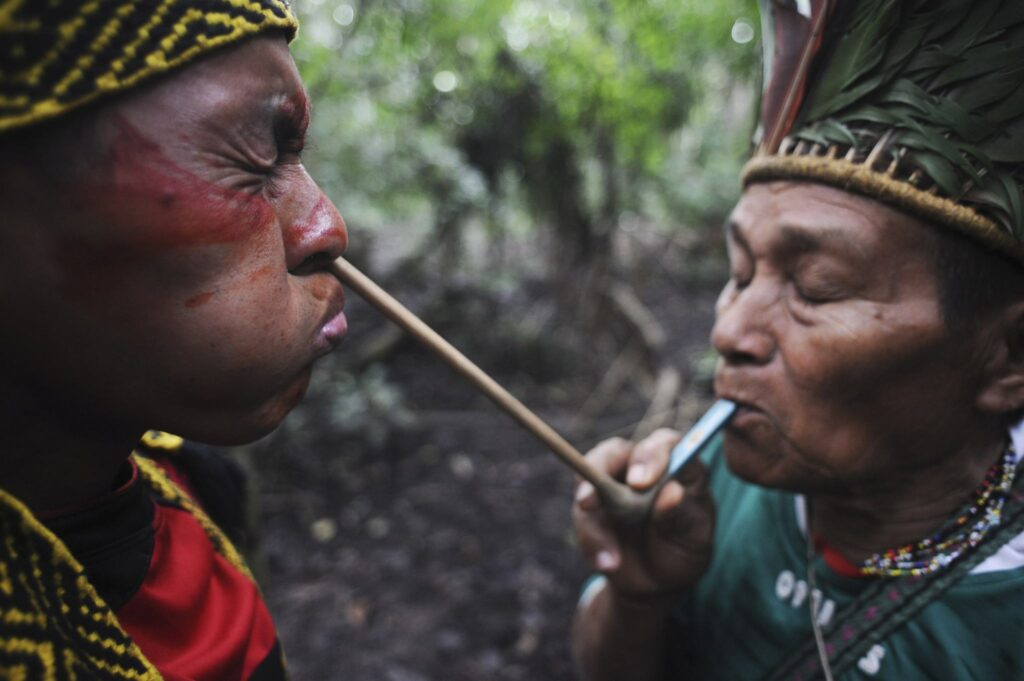
As soon as Rapé enters your nose, it’s quickly assimilated into your bloodstream through your mucous membranes. The constituents attach to nicotine receptors, triggering an increase in dopamine, acetylcholine, and epinephrine. The chemicals involved in this process produce feelings of relaxation and calm, but also keep the person feeling aware and alert. The effect is almost immediate.
Once the initial effects start to set in, close your eyes, take deep breaths, and focus on what you want to achieve. Watery eyes are common due to Rapé’s nose-clearing properties and because it acts as a purgative for many people.
Safety
Like any other substance, rapé can be abused for recreational purposes rather than being consumed in a sacred manner.
If you use rapé too often, it can lead to sinus problems and damage your respiratory system.
It is also important to keep in mind that combining rapé with other drugs, such as MDMA, is not recommended because the contraindications may be unknown. Rapé is frequently provided during ayahuasca ceremonies, but you should listen to your body and see whether rapé is really what it needs at the time.
Storing Rapé
Non-indigenous Brazilians prefer to use glass test tubes with screw tops as containers. These are easy to carry around and make it easier to pour rapé into the palm of your hand.
For long-term storage, keep rapé in a cool and dry place. If you notice your rapé is beginning to go bad, it will usually smell acrid. To salvage it, lay the rapé out on a clean cloth or smooth surface and let it dry in direct sunlight.
Keep in mind that medicinal rapé has a shelf life and its efficacy will reduce over time. Use it as soon as possible for the best results.
Where to find Rapé online?
Before experiencing the energy-cleansing effects of rapé, make sure to buy from a reputable source and educate yourself.
We’ve partnered with our friends at Shayana Shop to bring you a selection of some favorite rapés so far. Their Rapé blends are sourced from many indigenous tribes in the Amazonian regions of Brazil and Peru, including the Kaxinawa, Kuntanawa, Nukini, and Yawanawa.
Is it legal to possess and use Rapé?
According to our understanding, the majority of law enforcement around the globe does not consider rapé a drug.
Although, because snuff shamanic tobacco can be produced with a variety of plants, it may be legally treated as a narcotic if it includes prohibited chemicals.
For example, if rapé contains a high amount of coca leaves, it may be considered a narcotic in most nations where cocaine is banned. However, in Peru and Colombia, where possession and cultivation of coca plants are lawful in specific quantities and conditions, it can be permissible.
European legislation allows you to carry up to 1 kg of tobacco through immigration. Similar rules apply to the US.
As you read and learn about different medicines, like Rapé, you open yourself up to new possibilities for growth and development. Keep reading our blog to gain a deeper understanding of things that can help improve your overall well-being.

